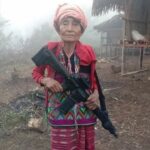
Her presence is a testament to the resilience of the Chin people, who have long faced persecution but have refused to surrender their autonomy. Historically, the Chin, a predominantly Christian ethnic minority, have suffered systematic oppression at the hands of successive Burmese governments. After the military coup of February 1, 2021, when the Tatmadaw (Myanmar’s military) seized control from the democratically elected government, Chin State quickly became one of the centers of armed resistance.
Civilians, including women, took up arms against the junta, forming local defense groups known as the Chinland Defense Force (CDF). The woman in this moment of quiet vigilance is more than a fighter—she represents the growing role of women in Myanmar’s pro-democracy struggle. The Chin, long known for their fiercely independent spirit, are now at the forefront of a larger battle to protect their people and their way of life.
The conflict in Chin State is part of a broader history of ethnic resistance in Myanmar, where minority groups such as the Karen, Kachin, and Shan have fought against the central government’s attempts to impose Burman dominance. After the coup, the Chin National Army (CNA), which had once entered ceasefire agreements with the government, joined forces with newly formed People’s Defense Forces (PDFs) to combat the junta’s brutal crackdowns.
Entire villages, including Thantlang and Mindat, were burned to the ground by the military, forcing thousands of civilians to flee into the jungles or across the border into India. Women have played an increasingly visible role in these resistance movements, both as fighters and as community leaders organizing aid, intelligence, and medical care.
Many, like the woman in the photo, never imagined they would have to pick up a weapon—but in the face of escalating violence, they see no other choice. With the international community slow to intervene, these local defense forces have relied on homemade weapons, captured firearms, and guerrilla tactics to push back against the junta’s forces.
Despite the odds, the Chin resistance continues to hold strong. The military’s failure to fully subdue Chin State reflects the deep-rooted determination of its people, who have endured hardship for generations. Historically, the Chin were never fully colonized by the Burmese kings, and during British rule, they maintained a degree of autonomy in their mountainous homeland. Today, that same spirit of defiance fuels their resistance.
The woman in the photograph, like many others, may not have sought war, but she embodies a broader struggle for self-determination and freedom. Her stance is not just about protecting her home—it is about ensuring that future generations of Chin people can live without fear.
While the conflict in Myanmar remains unresolved, the resilience of ethnic minorities like the Chin continues to challenge the military’s grip on power, proving that even against overwhelming force, the spirit of resistance endures.










Leave a Reply